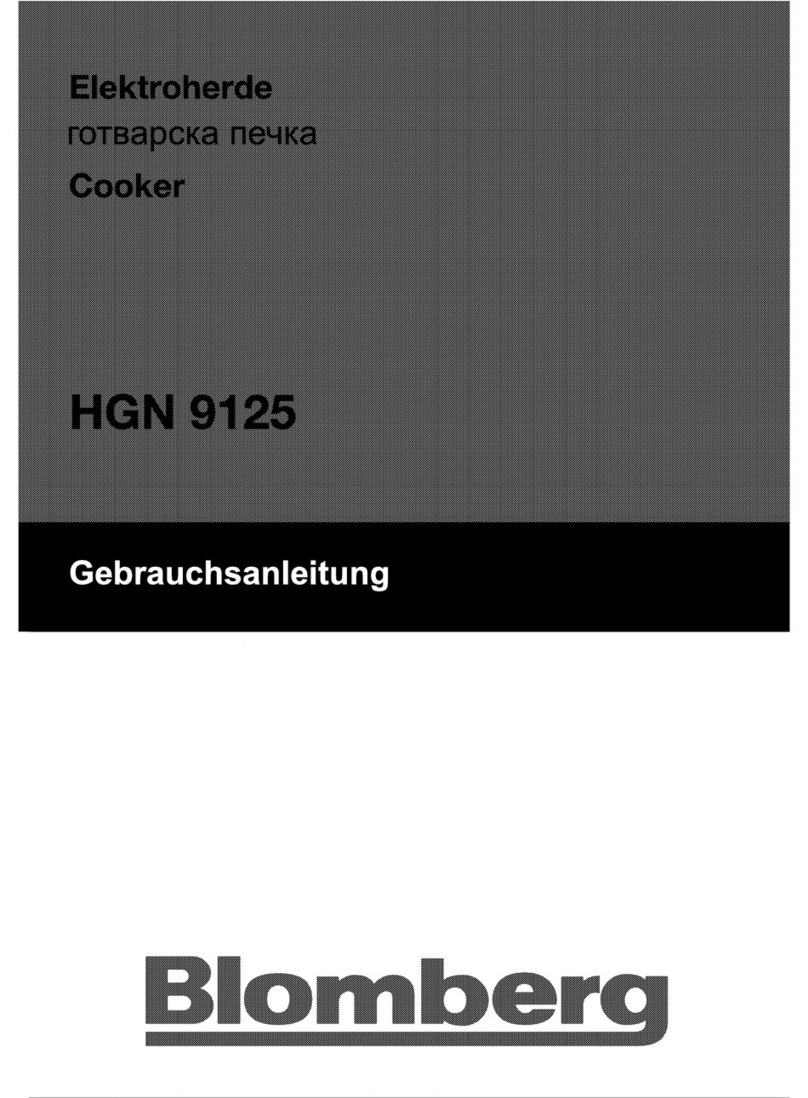Blomberg WSN 1412 LT User manual

WSN 1412 LT
UK - Wine Cooler
DE - Weinkühlschrank
FR - Cave á vin
DK - Vinkøleskab
NO - Vinkjøleskap
NL - Winkoelkast
ES - Armario Bodega
CZ - Chladnickou vino
PL - Chlodziarke do win
IT - Frigorifero per vino
RU - винный холодильник
UK Instructions for use
DE Bedienungsanleitung
FR Mode d'emploi
DK Brugsanvisning
NO Bruksanvisning
NL Gebruiksaanwijzing
ES Instrucciones para el uso
CZ Návod k použití
PL Instrukcja obsługi
IT I Istruzioni per l'uso
RU Инструкция к применению

Get to know your wine cooler.................3
Installation and start-up..........................4
Reversible door......................................7
Electrical connection ..............................8
Operation and function...........................9
Defrosting, cleaning and maintenance...11
Fault finding............................................12
Warranty, spare parts and service .........13
Disposal .................................................14
Lernen Sie Ihren
Kühlschrank kennen............................16
Inbetriebnahme und Installation ..........17
Wendbare Tür......................................20
Elektrischer Anschluss ........................21
Bedienung und Funktion .....................22
Abtauen, Reinigung und Wartung .......24
Fehlersuche.........................................25
Reklamation,
Ersatzteile und Service........................26
Entsorgung ..........................................27
Pour apprendre à
connaître votre réfrigérateur................29
Mise en service et installation .............30
Porte réversible ...................................33
Raccordement électrique ....................34
Utilisation et fonctionnement ...............35
Dégivrage, nettoyage et entretien .......37
Recherche des
pannes éventuelles .............................38
Garantie, pièces de
rechange et service après-vente .........39
Mise au rebut.......................................40
Lær køleskabet at kende.....................42
Ibrugtagning og installation .................43
Vendbar dør.........................................46
El-tilslutning .........................................47
Betjening og funktion...........................48
Afrimning rengøring
og vedligeholdelse...............................50
Fejlfindingsliste....................................51
Reklamation, reservedele og service ..52
Bortskaffelse........................................53
Bli kjent med kjøleskapet.....................55
Start og installasjon .............................56
Vendbar dør.........................................59
Elektrisk tilkobling................................60
Betjening og funksjon ..........................61
Avriming,
rengjøring og vedlikehold ....................63
Feilsøkingsliste....................................64
Reklamasjon,
reservedeler og service .......................65
Kassering ............................................66
Uw koelkast leren kennen ...................68
Installatie en ingebruikneming.............69
Links- of
rechtsdraaiend te monteren ................72
Aansluitspanning .................................73
Bediening en functie............................74
Ontdooien,
reinigen en onderhouden ....................76
Fouten opsporen .................................77
Reclamatie,
reservedelen en service ......................78
Verschroten .........................................79
EN-Contents DE-Inhalt
FR-Sommaire DA-Indhold
NO-Innhold NL-Innhold

Conozca su armario bodega ...............81
Instalación
y puesta en marcha inicial...................82
Puerta invertible ..................................85
Conexión eléctrica...............................86
Operación y funcionamiento................87
Descongelación,
limpieza y mantenimiento....................89
Lista de localización de fallos..............90
Garantía, repuestos y servicio.............91
Eliminación del aparato .......................92
ES-Indice
Seznamte se s chladničkou .................94
Uvedení do provozu a instalace...........95
Záměna otevírání dveří ........................98
Zapojení do sítě...................................99
Provoz a funkce ...................................100
Odtávání, čištění a údržba ...................102
Seznam odstraňování poruch..............103
Záruka, náhradní díly a servis ..............104
Likvidace..............................................105
CZ-Obsah
Общий вид винного холодильника...133
Установка и запуск ...........................134
Перевешивание двери .....................137
Подключений к электросети............138
Работа и функции ..............................139
Размораживание,
уборка и обслуживание....................141
Возможные неисправности и
их устранение ....................................142
Гарантии, запасные части и сервисное
обслуживание....................................143
Утилизация.........................................144
RU-Содержание
Budowa urządzenia .............................107
Ustawienie
i warunki pracy urządzenia...................108
Możliwość zmiany
kierunku otwierania drzwi ....................111
Podłączenie zasilania ...........................112
Obsługa i funkcje.................................113
Odszranianie,
mycie i konserwacja.............................115
Lokalizacja usterek...............................116
Reklamacje, części zamienne
oraz serwis urządzenia.........................117
Usuwanie ............................................118
Impari a conoscere il
Suo frigorifero per vini .........................120
Installazione e messa in funzione .......121
Sportello reversibile.............................124
Connessioni elettriche .........................125
Gestione e funzionamento ..................126
Sbrinamento,
pulizia e manutenzione........................128
Ricerca guasti......................................129
Garanzia, parti di
ricambio e assistenza..........................130
Smantellamento ..................................131
IT-Indice
PL-Spis treści

2
Thank you for purchasing your new wine cooler from Blomberg. Please
note that these instructions apply to all wine coolers in the WSN range.
Illustrations and fittings may therefore not necessarily correspond exactly to
your model.
WARNING: - keep ventilation openings, in the appliance
enclosure or in the built-in structure, clear of obstruction.
WARNING: - do not use mechanical devices or other means
to accelerate the defrosting process, othet than those
recommended by the manufacturer,
WARNING: - do not damage the refrigerant system.
WARNING: - do not use electrical appliances inside the
refrigerated storage compartments, unless they are of the
type recommended by the manufacturer.
The appliance shall not be exposed to rain.
* Keep always the keys in separate place and out of reach of children.
* Before servicing or cleaning the appliance, unplug it from the mains.
As the appliance contain a refrigerant which is flammable (Isobutane R600a)
it is essential to ensure that the refrigerant pipes are not damaged. If damage
does occur, avoid sparks or naked flame in the vicinity of the appliance, ensure
that the room is well ventilated, disconnect the power supply, and contact your
supplier. The unit must only be serviced by qualified technicians from an
approved service centre.
This appliance is not intended for use by young children or infirm persons
unless they have been adequately supervised by a responsible person to
ensure that they can use the appliance safely”.
“Young children should be supervised to ensure that they do not play with the
appliance”.
Old appliances
Old refrigerators and freezers are often fitted with complicated latches that
can only be opened from the outside. If you have one of these old units stored
away somewhere, or if you scrap one, remember to destroy the latch first in
order to prevent children from being exposed to great danger by getting locked
inside the unit.

3
Before use
Before operating your new appliance, please read the following instructions
carefully as they contain important information on safety, installation, operation
and maintenance. Keep the instructions for future reference.
On receipt, check to ensure that the appliance has not been damaged during
transport. Transport damage should be reported to the local distributor before
the wine cooler is put to use.
Remove the packaging. Clean the inside of the cabinet using warm water with
a mild detergent. Rinse with clean water and dry thoroughly (see cleaning
instructions). Use a soft cloth.
If during transport the appliance has been laid down, or if it has been stored
in cold surroundings (colder than +5°C), it must be allowed to stabilise in an
upright position for at least an hour before being switched on.
Get to know your wine cooler
Lighting
Charcoal filter
Wooden shelf
Sealing strip
Nameplate
Door handle
Kick plate
Control panel
Lock
Adjustable feet
Fig. 1

4
Placement
For safety and operational reasons,
the appliance must not be installed
outdoors.
The appliance should be placed on
a level surface in a dry, well
ventilated room (max.75% relative
air humidity). Never place the
appliance close to sources of heat
such as cookers or radiators, and
avoid placing it in direct sunlight.
Room temperature
The climate class is stated on the
nameplate (see fig. 1 on page 3 and
fig. 11 on page 13). This specifies
the optimum room temperature.
Wine coolers with winter position,
however, function at room
temperatures as low as 5ºC.
Installation
The surface on which the appliance
is to be placed must be level. Do
not use a frame or similar.
The appliance can be installed as a
freestanding unit against a wall,
built into a kitchen element, or lined
up with other appliances (figs 2-3).
Installation and start-up
600
600
Climate class Optimum room
tem- perature
SN +10 ºC to +32 ºC
N+16 ºC to +32 ºC
ST +18 ºC to +38 ºC
T+18 ºC to +43 ºC
Fig. 2
Fig. 3

5
The appliance viewed from
above
If the appliance is placed beside a
wall, there must be sufficient room
for its door to be opened wide
enough to allow the shelves to be
pulled out (fig. 4).
Ventilation
It is important that the appliance be
well ventilated and that air can
circulate unhindered above, below
and around it. The figures below
illustrate how the necessary air
circulation around the appliance can
be ensured (figs 5-6).
The distance pieces on the rear of
the appliance ensure sufficient air
circulation. Fit the two caps supplied
with the appliance as shown in
fig. 7.
Fig. 4
Fig. 6
Fig. 7
Fig. 5
1650/1950
100
100
1560/1860
600
1075

6
Setting up
It is important that the appliance be
absolutely level. It can be levelled by
screwing the adjustable feet at the
front of the appliance up or down (figs
8-9). Use a spirit level to check that
the appliance is absolutely level
sideways.
Fig. 8

7
The door can be changed from right-hinged to left-hinged and vice versa as
follows:
Reversible door
1. Lay the appliance on its
back and loosen the upper
hinge.
2. Remove the upper hinge. 3. Rotate the glass door
through 180° (on WSN 1412
LT, pull the handle to loosen it
on the inside from beneath the
sealing strip).
4. Carefully remove the
covers on the side of the
plinth using a flat-headed
screwdriver.
5. Pull up the hinge pin...
...and fit it on the opposite
side.
6. Unscrew the lock pin using
a flat-headed screwdriver.
7. When the lock pin has
been loosened completely,
pull it up together with the lock
cylinder and refit on opposite
side.
8. Click the covers into place
on the plinth sides on the
opposite side.
9. Fit the door onto the bottom
pin, fit the top hinge and
tighten securely.
10. After reversing the door, it is important to check that the sealing strip provides a tight seal all
the way round. If it does not, carefully heat the strip all the way round using a hair dryer. Then
ease the strip outwards slightly so that it forms a tight seal against the cabinet. Be careful not to
heat the strip so much that it melts!

8
The appliance is intended for connection to alternating current. The required
voltage (V) and frequency (Hz) are stated on the nameplate inside the
appliance. Power must be connected via an independent wall socket outlet.
If the supply cord is damaged, it must be replaced by the manufacturer,
its service agent or a similar qualified person in order to avoid a hazard.
Technical data
This appliance complies with CE marking regulations, directives and
standards. Low Voltage Directive 73/23/EEC.
EMC Directive 89/336/EEC.
Electrical connection

9
Electronic controls
The electronic controls ensure that the set temperatures are maintained at
the top and bottom of the cabinet. This is accomplished by complex control
of the refrigerating system the heating element and the fan. Following any
power failure, the temperature settings are automatically recalled.
The electronic controls have the following functions:
• Temperature setting
• Temperature display
• Automatic defrosting
• Fault-finding, emergency and service programs
• Low-temperature alarm
On/off switch
The light switch is used to select either continuous illumination or
illumination only when the door is opened.
Temperature display
The display shows the actual temperature at the top or bottom of the cabinet.
To switch the display between the top and bottom sections, short-press the
top and bottom buttons respectively, which section is shown is indicated by a
line of light in the display just beside the buttons. The temperature display has
a built-in filter that simulates the actual temperature in the bottles. The
displayed temperature is therefore not affected by transient fluctuations in air
temperature.
Temperature setting
The temperature is set using the two buttons on the control panel. The upper
button is used to set the temperature at the top of the cabinet. The lower
button is used to set the temperature at the bottom. Deactivate the childproof
lock by pressing the button for 3 seconds. The display then starts flashing
Operation and function
Fig. 9
On/off switch Light switch

10
and shows the current temperature setting for the zone concerned. This
applies to both buttons/sections. When the display starts flashing, the
temperature can be set by scrolling the setting between 22 and 5°C. When
the desired setting is displayed, release the button for 3 seconds. The setting
will then be stored and the childproof lock reactivated.
Note that the bottom section cannot be given a higher temperature setting
than the top section. The highest available temperature setting for the bottom
section is therefore identical to the actual setting for the top section.
Low-temperature alarm
If the temperature has been below 2°C for more than 1 hour, the display
flashes and Lo/actual temperature are alternately shown. Wine cannot mature
properly at sub-zero temperatures.
Two-zone setting for serving temperature
Typical serving temperature settings for the top and bottom sections are 16°C
and 6°C respectively. With these settings, a suitable temperature gradient will
be achieved in the cabinet for the storage of various types of wine distributed
from top to bottom as follows:
- heavy red wines +16 to +19°C
- rosé and light red wines +12 to +16°C
- white wines +10 to +12°C
- champagne and sparkling wines +6 to +8°C
It is recommended that wine be served at a temperature which is a couple of
degrees lower than the desired drinking temperature as the wine will be
warmed slightly when it is poured into the glass.
Single-zone setting for long-term storage.
For long-term wine storage, the top and bottom sections should both be set
at 12°C. With identical settings for the top and bottom sections, the controls
will maintain an even temperature throughout the cabinet. However, the
temperature in the room will gradually affect the temperature in the cabinet
through its door and sides, creating a slight temperature gradient from top to
bottom. The controls will maintain the set temperature at the bottom of the
cabinet, and any deviation from the setting will therefore occur at the top.
The difference will vary from 0 to 3°C, depending on the ambient temperature.

11
Automatic defrosting
The wine cooler is defrosted automatically. Defrost water runs through a pipe
and is collected in a tray above the compressor where the heat generated by
the compressor causes it to evaporate. The defrost water tray should be
cleaned at intervals.
Cleaning
Before cleaning the appliance, unplug it from the main supply. The cabinet is
best cleaned using warm water (max. 65°C) with a little mild detergent. Never
use cleaning agents that scour. Use a soft cloth. Rinse with clean water and
dry thoroughly. The defrost water channel, in which condensation from the
evaporator runs, is located at the bottom of the rear inside wall of the cabinet
and must be kept clean. Add a few drops of disinfectant, e.g. Rodalon, to the
defrost water drain a couple of times a year, and clean the drain using a pipe
cleaner or similar. Never use sharp or pointed implements. The sealing strip
around the door must be cleaned regularly to prevent discolouration and
prolong service life. Use clean water. After cleaning the sealing strip, check
that it continues to provide a tight seal. Dust collecting on the condenser on
the rear of the cabinet, the compressor and in the compressor compartment
is best removed using a vacuum cleaner.
Replacing the light tube
Before replacing the light tube,
unplug the appliance from the main
supply. Remove the lamp cover
using a small flat-headed
screwdriver. Replace the PLC tube
(11 W). Refit the lamp cover,
reconnect the power supply and
start the appliance by pressing the
on/off switch.
Defrosting, cleaning and maintenance
Fig. 10

12
Fault finding
Fault Possible cause Remedy
The appliance is
“dead”!
The appliance is switched off.
Power failure; the fuse is blown;
the appliance is not plugged in
correctly.
Press the on/off switch.
Check that power is connected.
Reset the fuse.
Water collects in the
bottom of the
cabinet.
The defrost water pipe is
blocked.
Clean the defrost water channel
and the drain hole on the rear
wall of the cabinet.
Vibration or
bothersome noise.
The appliance is not level.
The appliance is resting against
other kitchen elements.
Containers or bottles inside the
cabinet are rattling against one
another.
Level the appliance using a
spirit level.
Move the appliance away from
the kitchen elements or
appliances it is in contact with.
Move containers and/or bottles
apart.
Compressor runs
continuously.
High room temperature. Ensure adequate ventilation.
E1 is shown on the
display.
The upper sensor is
disconnected or short-circuited.
Call for service. The
temperature within the entire
cabinet is maintained at the
higher of the two setpoints until
the fault has been corrected.
E2 is shown on the
display.
The lower sensor is
disconnected or short-circuited.
Call for service. The
temperature within the entire
cabinet is maintained at the
higher of the two setpoints until
the fault has been corrected.
ULO is shown on the
display.
The mains voltage is lower than
184 V.
UHI is shown on the
display.
The mains voltage is higher
than 255 V.

Warranty disclaimer
Faults and damage caused directly or indirectly by incorrect operation, misuse,
insufficient maintenance, incorrect building- in, installation or mains connection,
fire, accident, lightening, voltage variation or other electrical interference,
including defective fuses or faults in mains installations, or repairs performed
by others than service centres approved by Blomberg, and any other faults
and damage that the manufacturer can substantiate are caused by reasons
other than manufacturing or material faults are not covered by the warranty.
Transport damage discovered by the buyer is primarily a matter to be settled
between the buyer and the distributor, i.e. the distributor must ensure that
such complaints are resolved to the buyer's satisfaction.
Before calling for technical assistance, please check whether you are able to
rectify the fault yourself (see Fault finding). If your request for assistance is
unwarranted, e.g. if the appliance has failed as a result of a blown fuse or
incorrect operation, you will be charged the costs incurred by your call for
technical assistance.
Note: Always use approved service centres when your appliance is to
be repaired or replaced!
13
Warranty, spare parts and service

14
Environmental regulations on disposal must also be observed. When disposing
of the appliance you should contact your local authority technical department
who will inform you of how collection and recycling of such units take place
in your area.
This appliance is marked according to the European directive 2002/96/EC on
Waste Electrical and Electronic Equipment (WEEE).
By ensuring this product is disposed of correctly, you will help prevent potential
negative consequences for the environment and human health, which could
otherwise be caused by inappropriate waste handling of this product.
The symbol on the product, or on the documents accompanying the
product, indicates that this appliance may not be treated as household waste.
Instead it shall be handed over to the applicable collection point for the
recycling of electrical and electronic equipment.
Disposal must be carried out in accordance with local environmental
regulations for waste disposal.
For more detailed information about treatment, recovery and recycling of this
product, please contact your local city office, your household waste disposal
service or the shop where you purchased the product.
Disposal

15
Vielen Dank für Ihre Wahl eines Weinkühlschranks von Blomberg. Beachten
Sie bitte, dass die Bedienungsanleitung für alle Weinkühlschränke der WSN-
Serie gilt. Darum entsprechen Abbildungen und Ausstattung nicht in jedem
Fall genau Ihrem Gerät.
Warnungs
Da ein brennbares Gas (Isobutan R600a) als Kältemittel
dient, ist besondere Vorsicht bei Transport und Installation
geboten, damit kein Teil des Kühlkreislaufs beschädigt wird.
Sollte dies dennoch geschehen, vermeiden Sie Funken und
offenes Feuer! Lüften Sie den Raum gründlich, schalten Sie
danach die Stromzufuhr zum Gerät aus, und wenden Sie
sich an Ihren Lieferanten.
Wartungs- und Reparaturarbeiten dürfen nur von einem
qualifizierten Servicecenter durchgeführt werden.
Alte Geräte
Alte Kühl- und Gefriergeräte sind häufig mit komplizierten Schnappschlössern
versehen, die von innen nicht geöffnet werden können. Falls bei Ihnen ein
solches Gerät steht, oder wenn Sie ein solches Gerät ausrangieren, machen
Sie bitte zuerst das Schloss unbrauchbar. So verhindern Sie, dass spielende
Kinder eingesperrt werden und in Lebensgefahr kommen können.
Vor dem Gebrauch
Vor dem Gebrauch Ihres neuen Geräts sollten Sie diese Bedienungsanleitung
gründlich lesen. Sie enthält wichtige Informationen zu Sicherheit, Installation,
Betrieb und Wartung. Bewahren Sie die Bedienungsanleitung auf. Sie könnten
sie zu einem späteren Zeitpunkt evtl. benötigen.
Kontrollieren Sie das Gerät sofort bei Lieferung auf eventuelle
Beschädigungen. Transportschäden sind dem Händler zu melden, bevor das
Gerät in Gebrauch genommen wird.
Verpackung entfernen. Das Schrankinnere mit lauwarmem Wasser und etwas
mildem Spülmittel reinigen. Mit klarem Wasser nachwischen und gründlich
trocknen (siehe “Reinigung” ). Verwenden Sie ein weiches Tuch.
Falls das Gerät liegend transportiert wurde oder einer Temperatur von weniger
als +5 °C ausgesetzt war, muss es vor dem Einschalten mindestens eine
Stunde lang bei höherer Außentemperatur aufrecht stehen.

16
Lernen Sie Ihren Kühlschrank kennen
Beleuchtung
Kohlefilter
Holzfach
Dichtleiste
Typenschild
Türgriff
Fußleiste
Bedienungselemente
Schloss
Einstellbare Füße
Abb. 1

17
Aufstellort
Aus Sicherheits- und
betriebstechnischen Gründen darf
das Gerät nicht im Freien aufgestellt
werden.
Stellen Sie den Schrank auf einen
ebenen Untergrund in einem
trockenen, gut belüfteten Raum
(max. 75 % relative Luftfeuchtigkeit).
Stellen Sie den Schrank nicht in
unmittelbarer Nähe
von Wärmequellen wie Herden oder
Heizkörpern auf, und vermeiden Sie
direkte Sonneneinstrahlung oder
Wärme von anderen Wärmequellen.
Raumtemperatur
Die Klimaklasse finden Sie auf dem
Typenschild (siehe Abb. 1 Seite 16
und Abb. 11 Seite 26). Sie gibt an,
innerhalb welcher
Raumtemperaturbereiche der
Kühlschrank optimal arbeitet.
Weinschränke mit Winterposition
fungieren bis zu einer
Raumtemperatur von 5 °C.
Installation
Die Unterlage zum Aufstellen des
Schranks muss eben sein.
Verwenden Sie keinen Rahmen o.ä.
Der Schrank kann frei an einer Wand
stehen, in ein Küchenelement
eingebaut werden oder neben
anderen Schränken aufgestellt
werden (Abb. 2-3).
Inbetriebnahme und Installation
600
600
Klimaklasse Zulässige
Raumtemperatur
SN +10 ºC bis +32 ºC
N+16 ºC bis +32 ºC
ST +18 ºC bis +38 ºC
T+18 ºC bis +43 ºC
Abb. 2
Abb. 3

18
Schrank in Draufsicht
Wird der Schrank an einer Wand
aufgestellt, ist darauf zu achten,
soviel Platz zu lassen, dass die Tür
zum Herausziehen der
Kühlschubladen weit genug
geöffnet werden kann (Abb. 4).
Belüftung
Der Schrank muss ausreichend
belüftet sein, und die Luftzirkulation
über und unter ihm sowie seitlich
vom Schrank darf nicht behindert
sein.
Die folgenden Abbildungen zeigen,
wie die erforderliche Belüftung in
der direkten Umgebung des
Schranks sicherzustellen ist
(Abb. 5-6).
Die Abstandsstücke auf der
Rückseite des Schranks sichern die
erforderliche Luftzirkulation. Die
beiden Abdeckungen montieren, die
zusammen mit dem Schrank
mitgeliefert werden (siehe Abb. 7)
Abb. 4
Abb. 6
Abb. 7
Abb. 5
1650/1950
100
100
1560/1860
600
1075
Table of contents
Languages:
Other Blomberg Kitchen Appliance manuals
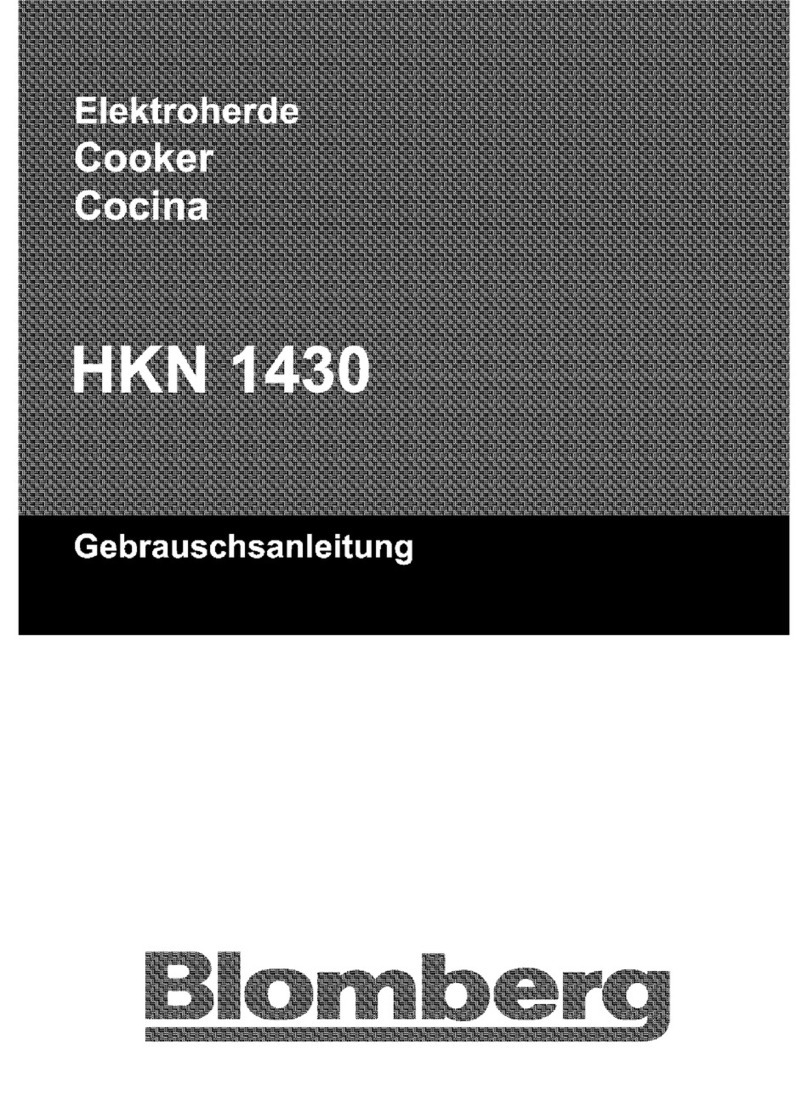
Blomberg
Blomberg HKN 1430 User manual

Blomberg
Blomberg GCS 43203 User manual
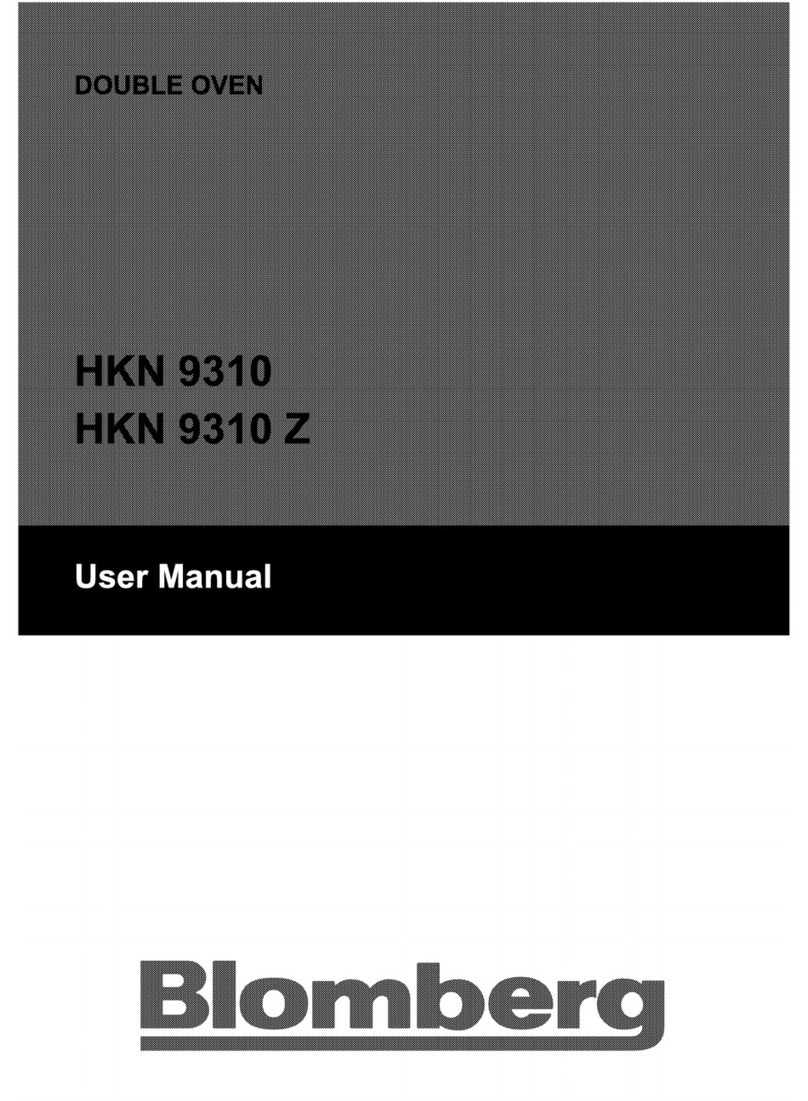
Blomberg
Blomberg HKN 9310 Z User manual
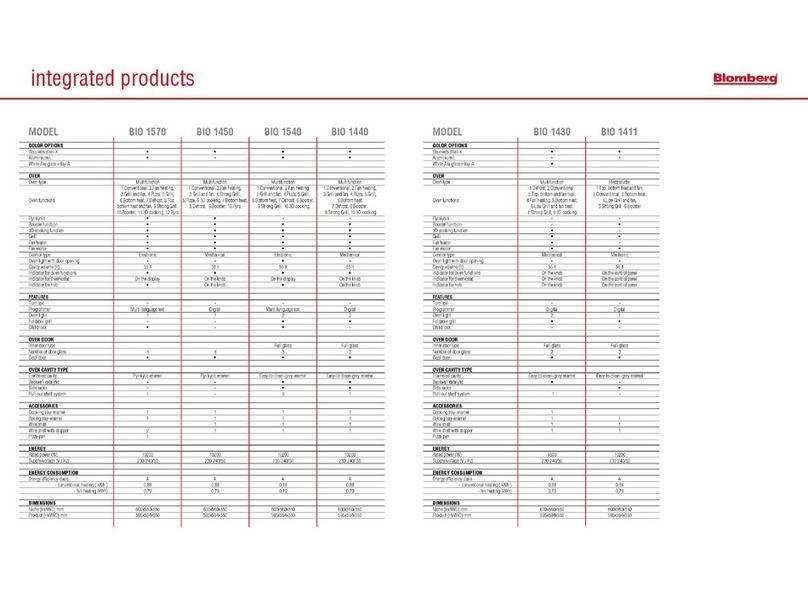
Blomberg
Blomberg MEE 2020 User manual
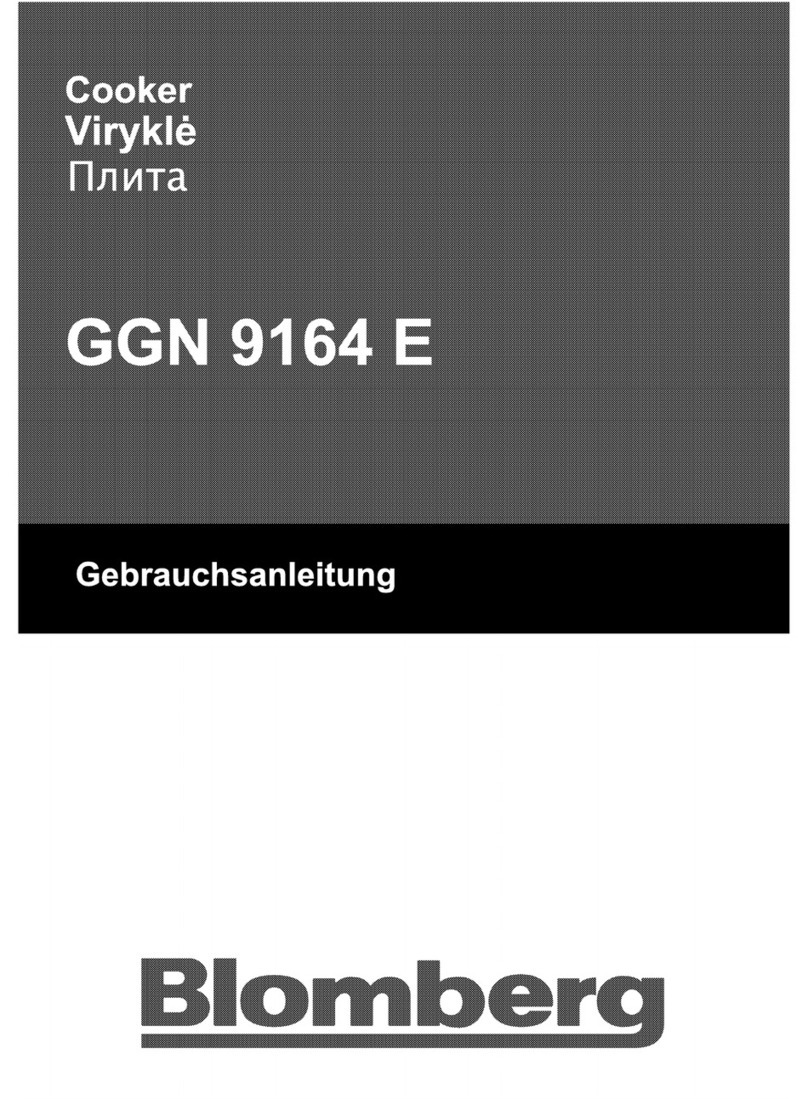
Blomberg
Blomberg GGN 9164 E User manual
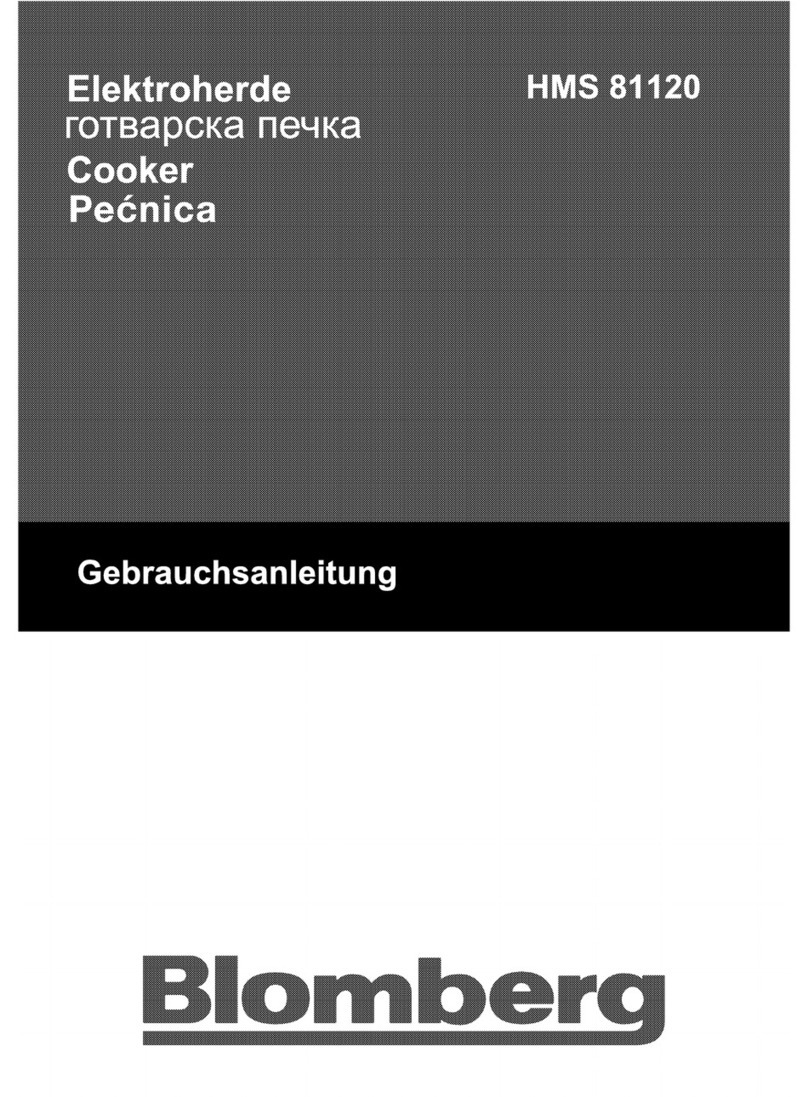
Blomberg
Blomberg HMS 81120 User manual
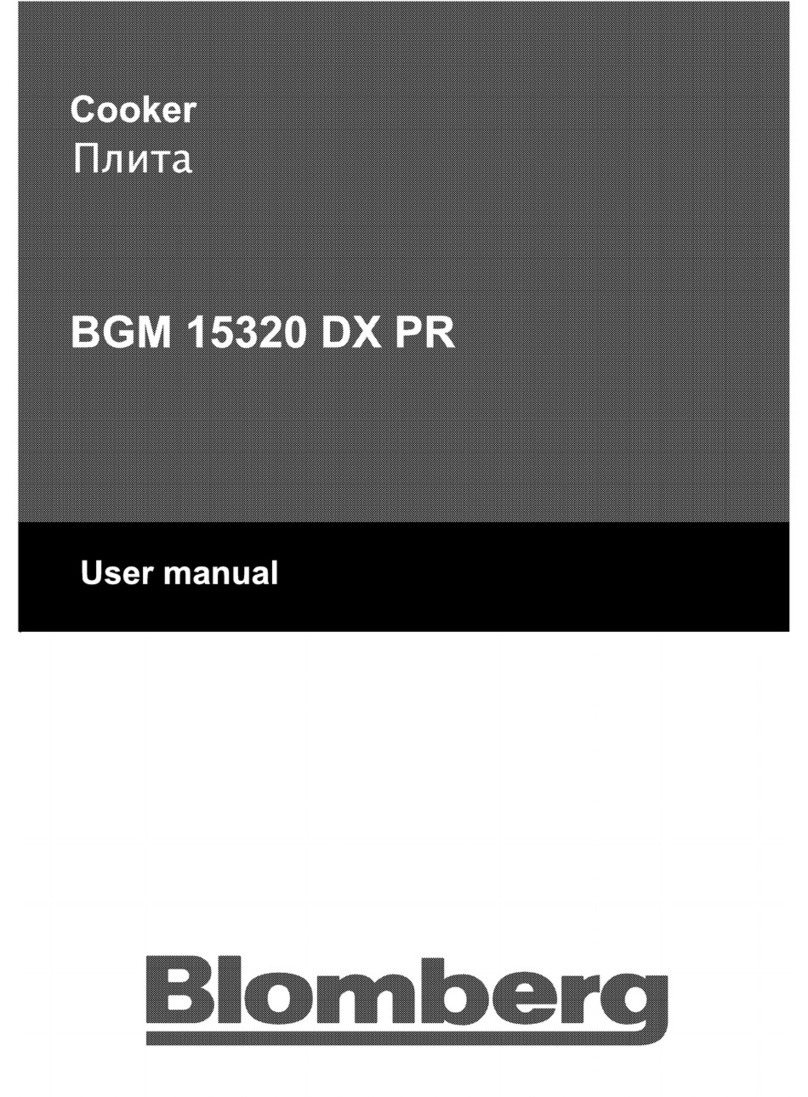
Blomberg
Blomberg BGM 15320 DX PR User manual
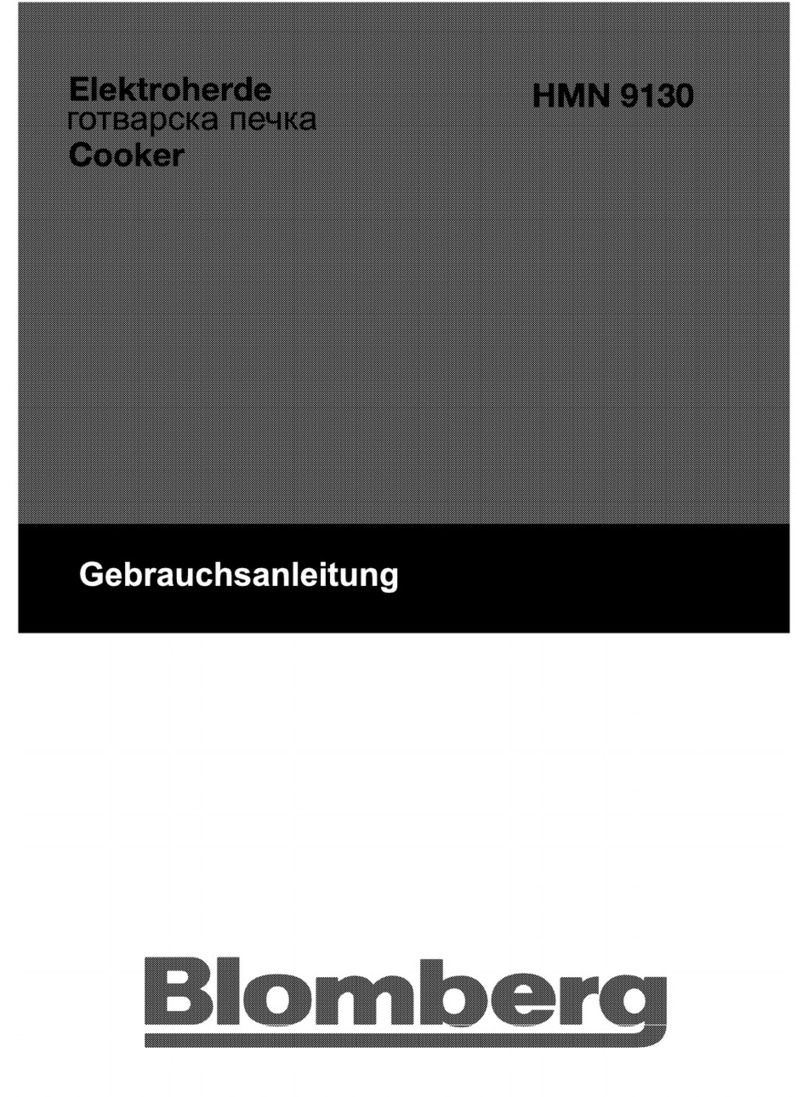
Blomberg
Blomberg HMN 9130 User manual
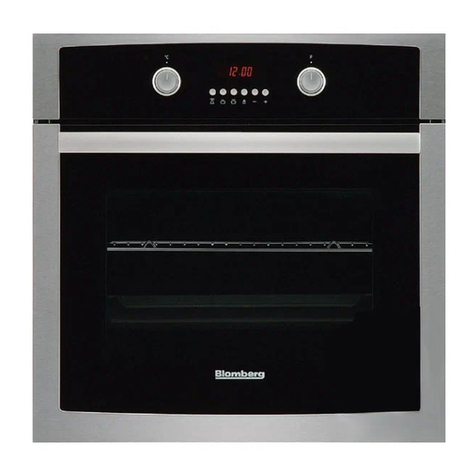
Blomberg
Blomberg BEO 1011 User manual

Blomberg
Blomberg GGN 1010 User manual

